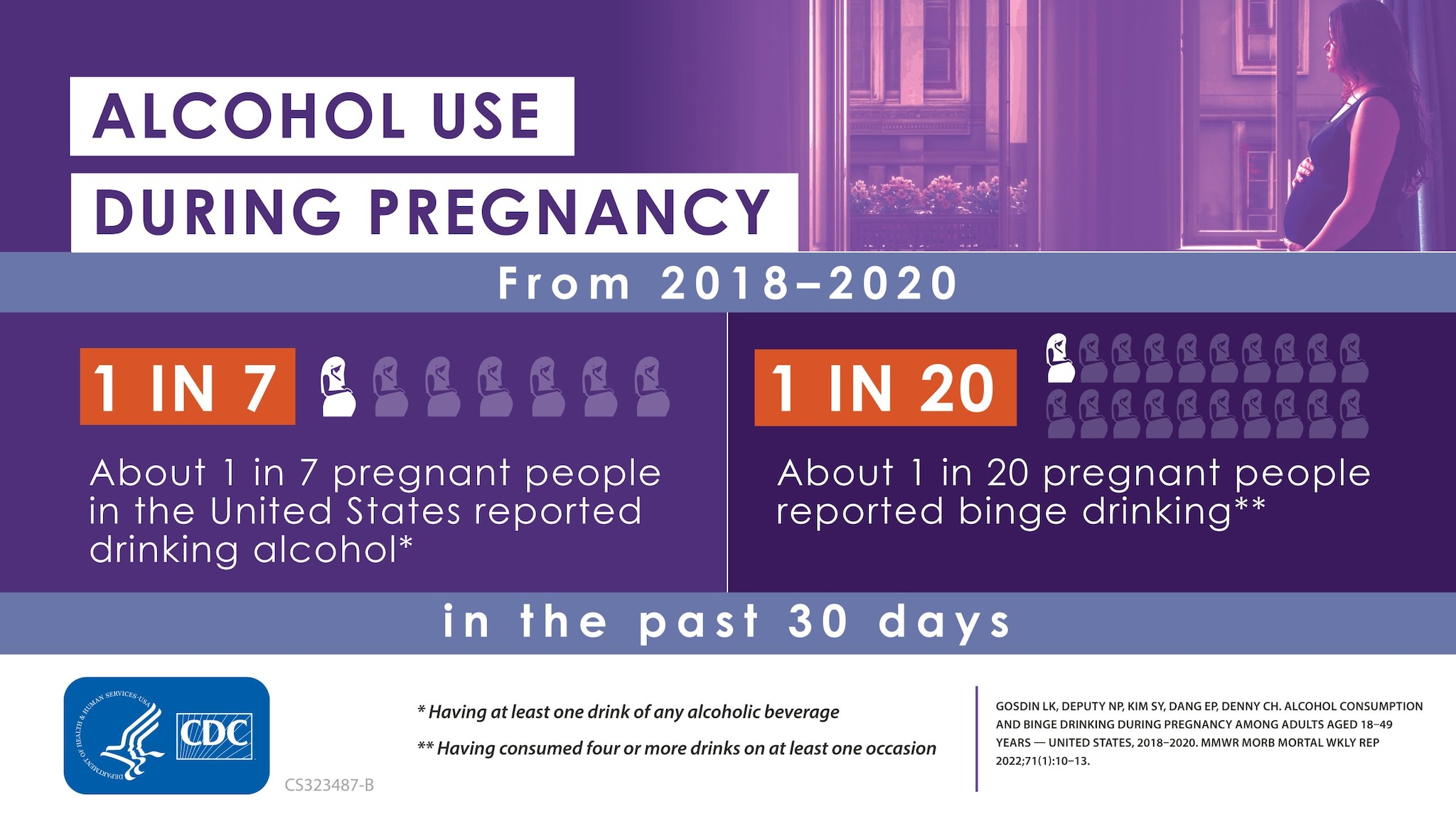What to know
- Alcohol use during pregnancy remains a serious public health concern.
- CDC uses multiple data sources to describe alcohol use patterns among pregnant people in the United States.

US data
Alcohol use among pregnant people in the United States

- Nearly 14% (or 1 in 7) pregnant people reported current drinkingA and about 5% (or 1 in 20) reported binge drinkingB in the past 30 days.1
- Pregnant people who experienced frequent mental distress (14 or more days of poor mental health in the past 30 days) and those who did not have a usual healthcare provider were more likely to report alcohol use.1
- Both current alcohol use and binge drinking among pregnant women aged 18–44 years in the United States increased slightly from 2011 to 2018. Current drinking (having at least one drink of any alcoholic beverage in the past 30 days) increased from 9.2% in 2011 to 11.3% in 2018.2
Data sources
Behavioral Risk Factor Surveillance System (BRFSS)
This telephone survey tracks national and state-specific health risk behaviors of adults, aged 18 years and older, in the United States. The BRFSS is administered and supported by the National Center for Chronic Disease Prevention and Health Promotion, CDC.
National Survey on Drug Use and Health (NSDUH)
This survey provides information on the prevalence, patterns, and consequences of alcohol, tobacco, and illegal drug use and abuse in the general U.S. population, 12 years and older. It is conducted by the Substance Abuse and Mental Health Services Administration.
National Health Interview Survey (NHIS)
The NHIS is a multi-purpose nationwide household health survey of the U.S. civilian noninstitutionalized populated conducted annually by the National Center for Health Statistics, CDC, to produce national estimates for a variety of health indicators.
Alcohol-Related Disease Impact (ARDI)
This software, supported by CDC's National Center for Chronic Disease Prevention and Health Promotion, generates estimates of alcohol-related deaths and Years of Potential Life Lost (YPLL) due to alcohol consumption.
- Having at least one drink of any alcoholic beverage
- Having consumed four or more drinks on at least one occasion
- Gosdin LK, Deputy NP, Kim SY, Dang EP, Denny CH. Alcohol Consumption and Binge Drinking During Pregnancy Among Adults Aged 18–49 Years — United States, 2018–2020. MMWR Morb Mortal Wkly Rep 2022;71:10–13. DOI: http://dx.doi.org/10.15585/mmwr.mm7101a2external icon.
- Denny CH, Acero CS, Terplan M, Kim SY. Trends in Alcohol Use Among Pregnant Women in the U.S., 2011-2018. Am J Prev Med. 2020; 59(5):768-9. https://doi.org/10.1016/j.amepre.2020.05.017.
- Luong J, Board A, Gosdin L, et al. Alcohol Use, Screening, and Brief Intervention Among Pregnant Persons — 24 U.S. Jurisdictions, 2017 and 2019. MMWR Morb Mortal Wkly Rep 2023;72:55–62. DOI: http://dx.doi.org/10.15585/mmwr.mm7203a2.
- McKnight-Eily LR, Okoro CA, Turay K, Acero C, Hungerford D. Screening for Alcohol Use and Brief Counseling of Adults — 13 States and the District of Columbia, 2017. MMWR Morb Mortal Wkly Rep 2020;69:265–270. DOI: http://dx.doi.org/10.15585/mmwr.mm6910a3.
